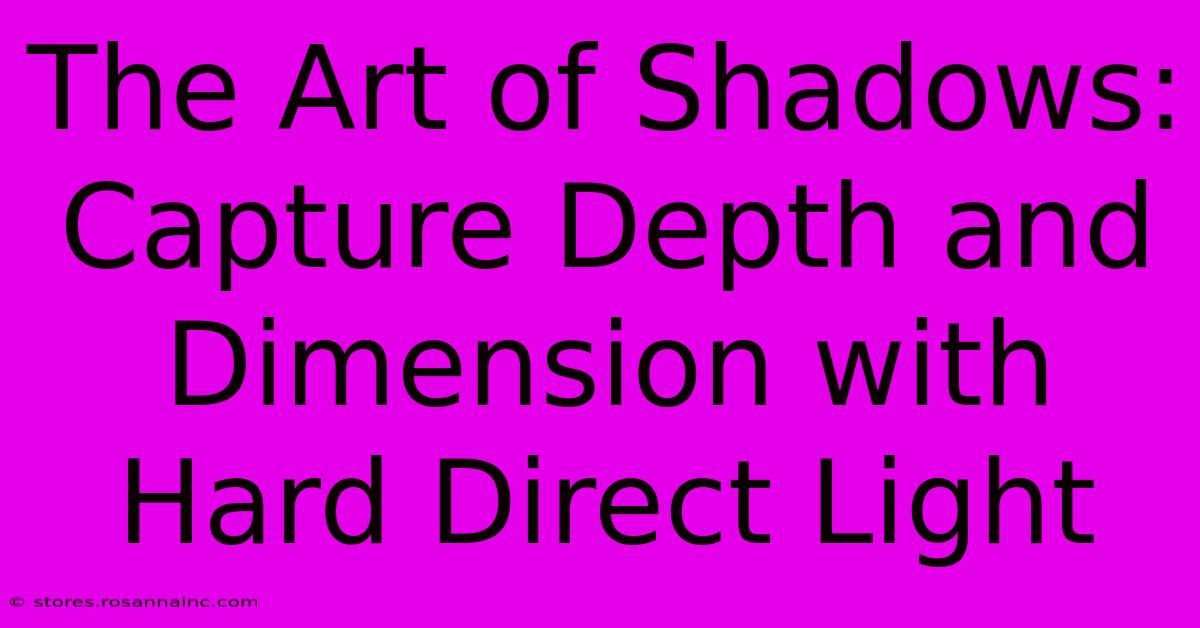The Art Of Shadows: Capture Depth And Dimension With Hard Direct Light

Table of Contents
The Art of Shadows: Capture Depth and Dimension with Hard Direct Light
Hard direct light. The phrase itself conjures images of stark contrasts, deep shadows, and a dramatic intensity that can transform an ordinary scene into something truly captivating. Mastering the art of using hard direct light—like that of the midday sun or a focused strobe—is key to unlocking a new level of depth and dimension in your photography. This isn't about avoiding harsh light; it's about embracing it and learning to wield its power.
Understanding Hard Light's Characteristics
Hard light is characterized by its small light source, resulting in sharply defined shadows with distinct edges. This is in contrast to soft light, which produces gentler, more diffused shadows. Think of the difference between the midday sun (hard) and the soft light of an overcast day. The smaller the light source relative to the subject, the harder the light will be.
Key Characteristics of Hard Direct Light:
- Strong Shadows: Deep, defined shadows are a hallmark of hard light. These shadows add significant depth and three-dimensionality to your images.
- High Contrast: The difference between the brightest and darkest parts of the image is pronounced, leading to a high contrast ratio.
- Dramatic Effects: Hard light can create dramatic and impactful scenes, ideal for conveying mood and atmosphere.
- Texture Emphasis: Hard light accentuates textures and surface details, adding visual interest.
Harnessing the Power of Shadows: Techniques and Tips
The secret to successful hard direct light photography lies in understanding how to control and manipulate the shadows. It's not about eliminating them; it's about using them to your advantage.
1. Mastering Shadow Placement:
- Consider your subject's orientation: How your subject is positioned relative to the light source drastically impacts the shadow's position and shape. Experiment with different angles.
- Use fill light strategically: A secondary light source (fill light) can soften harsh shadows without completely eliminating them. This maintains the drama while enhancing detail in shadowed areas. This could be a reflector, a secondary flash, or even ambient light.
- Embrace silhouette: Sometimes, the most striking images are created by embracing the silhouette effect. This technique works particularly well with subjects that have a recognizable shape.
2. Finding the Right Time of Day:
Midday sun, while harsh, offers the strongest direct light. However, the "golden hour" (sunrise and sunset) can also provide hard light with a warmer, more flattering quality. Experiment with different times to see how the light changes the shadows and overall mood.
3. Utilizing Fill Cards and Reflectors:
Reflectors and fill cards are invaluable tools for controlling hard light. These can bounce light back into shadowed areas, subtly softening the shadows and adding detail without losing the dramatic effect.
4. Post-Processing Techniques:
While in-camera techniques are crucial, post-processing can further refine your images. Tools like dodging and burning can subtly adjust the brightness and darkness of specific areas, enhancing the impact of shadows. However, resist over-processing; let the natural drama of the light shine through.
Beyond Still Photography: Expanding to Other Mediums
The principles of hard direct light extend beyond still photography. Think about how film noir uses dramatic lighting to create atmosphere, or how painters use chiaroscuro (the strong contrast between light and dark) to add depth to their work. Understanding hard light is fundamental to visual storytelling across various artistic mediums.
Conclusion: Embracing the Dramatic
Hard direct light offers a unique and powerful aesthetic. By understanding its characteristics and mastering techniques to control shadows, you can elevate your photography to new heights, capturing images that are both technically proficient and artistically compelling. Don't shy away from the challenge; embrace the drama of hard light and discover the captivating depth and dimension it can bring to your work.

Thank you for visiting our website wich cover about The Art Of Shadows: Capture Depth And Dimension With Hard Direct Light. We hope the information provided has been useful to you. Feel free to contact us if you have any questions or need further assistance. See you next time and dont miss to bookmark.
Featured Posts
-
From Joy To Jealousy The Surprising Spectrum Of Orange Roses
Feb 04, 2025
-
Unlock The Secrets Of Salon Quality Gel Polish With This Revolutionary Kit
Feb 04, 2025
-
Behind The Numbers Deciphering The Nil Pay Gap
Feb 04, 2025
-
Divine Chic Elevate Communion Celebrations With Exquisite Invitations
Feb 04, 2025
-
The Art Of The Written Word Marvel At Illuminated Manuscripts And Rare Books
Feb 04, 2025
